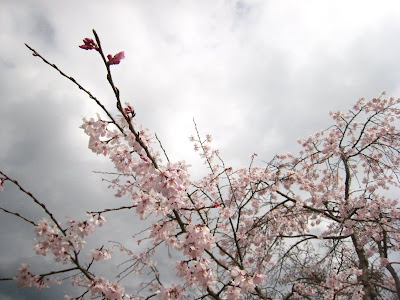
Every spring, the cherry blossom front sweeps its way across Japan. It starts in the south and moves its way north. It is fast, fleeting and blindingly beautiful.
If you were to videotape Japan from above, and then play it back in fast forward, you'd see a cotton-candy cloud of pale pink sweeping across the country, like the way sunlight races around the globe.
Blindingly beautiful and then gone. The cherry blossoms are a perfect metaphor for the fleeting nature of life. The idea that nothing is permanent or everlasting is a recurring theme in Japanese literature and poetry. And I think maybe that's why the Japanese appreciate cherry blossoms the way they do.


The entire country takes the arrival of the cherry blossoms very seriously. The nightly news report includes a segment tracking the movement of the cherry blossom front. Pictures of cherry trees are splashed all over the front pages of newspapers.
Across Japan, crowds of people are flocking to parks and gardens for flower viewing parties (known as hanami). Wherever there’s a tree in bloom, there’s a party happening underneath it.

You just spread a plastic tarp on the ground below a cherry tree and binge on booze while celebrating the fleeting beauty of the fluttering blossoms above your head.

When a shower of pastel petals floats down with every breeze, there is a gentle sadness in knowing the lives of the flowers will soon be over. But there is a beauty in the short-lived nature of the cherry blossoms too. It is an enjoyable sadness.
The cherry trees are just starting to bloom in Kyoto. I've been out taking pictures every day, and I'll continue to do so until the very last petal falls to the ground.







Maybe it's simplistic to say the sakura is my favourite flower. Maybe it's akin to admitting you like puppies and kittens (who doesn't?). But having a deep appreciation for life's transitory moments is something that resonates with me. And there is no more perfect metaphor for the fleeting nature of life than the pale pink cherry blossom.

More photos on my flickr page.




















